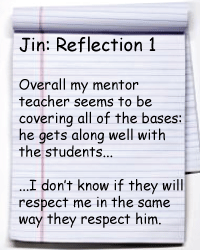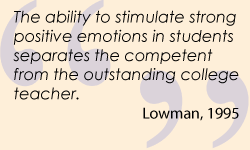 Building Student Rapport
Building Student Rapport
|
Erinn's case studyJin's case studyMarguerite's case study |
What is Student Rapport?
Building student rapport is the development of a positive relation between the teacher and the students. There are several techniques a teacher can use to develop this rapport; some techniques are geared towards the beginning of the course, where others are techniques that can be used on a day to day basis.
How can the Student-Teacher Relationship Aspect of Rapport be defined?
In their article Rapport-Building: Creating Positive Emotional Contexts for Enhancing Teaching and Learning William Buskist and Bryan K. Saville define the student teacher relationship as:
- the extent to which students accept or "buy into" the goals the teacher has spelled out to the class
- the student's ability to work toward these goals
- the teacher's ability to care genuinely for students and to nurture their learning
- the student and teacher "connecting" emotionally and students' motivation to participate actively in their education.
back to top
How can student rapport be developed?
 |
How can student rapport be developed? Watch the video and note what this language teacher does in order to develop positive relationships with her students. (1:43) |
After viewing the video of Miss Stephen were you able to brainstorm some ideas of how to build student rapport in the TL? Here are just a few strategies that can be used in order to help build rapport with students.
- Get to know the students both inside and outside of the classroom
- Learn student names as quickly as possible
- Consider non-verbal factors such as body language
- Develop a relationship built on trust
- Have a sense of humour and have fun with students!
What are some activities and strategies I can use to develop rapport?
Ice Breaker Activities
- Used at the beginning of the course to create a positive atmosphere in the class and between students and teacher.
- Can also be used to facilitate students (and teacher) getting to know each other.
- For ice breaker activities click here.
Activities to help learn student names
 |
Learning student names is an important part of building student rapport. Why do you think this is so? What are some strategies that you have experienced or used for learning student names? |
-
Passport – students are given time to create a passport about themselves, including relevant information and at least one piece of memorable information that will stick in the minds of others.
-
Student teams - putting the students in teams creates a pattern in your mind of where they sit. It is similar to a seating plan but letting the student compete with their groups makes it seem more like an activity.
-
Unforgettable Neighbour – have the students work in pairs or with partners and share a memorable fact about each other. They can then share these facts with the class so there is an additional fact to help make each student’s name easier to remember.
-
Adjective Name Game – similar to the unforgettable neighbor activity, students work in pairs but have to come up with an interesting adjective that starts with the same letter as their first name, ie: Meticulous Miranda, Artsy Anna.
-
Seating Chart – creating a seating chart allows the teacher to quiz himself about which student sits where and forces the teacher to make the mental connection.
Body Language Factors of which to be Aware
-
Smile! Show the students you are happy to be there and to see them.
-
Move around the classroom – as students get used to your presence, they will feel less intimidated by you and will be more likely to interact with you voluntarily
-
Make eye contact – this shows a sense openness, honesty and caring
-
Gestures – using lively and animated gestures demonstrates friendliness and that the teacher is involved in the material. It also helps keep the students alert and shows that the teacher isn’t afraid to make fun of his or herself from time to time.
-
Be aware of student discomfort – certain students will feel really uncomfortable with teacher proximity or excessive eye contact. Get to know who these students are so they can be given the space they require in order to feel safe and respected.
Developing Trust
-
Discuss trust with your students, its limits and its benefits. Having this discussion shows that the students are valued and respected enough to make their own decisions.
-
Laugh at your own mistakes! This shows that students can do the same, that you trust they will keep this within reason; this then allows for further amusing situations to happen later on, that students don’t feel so self-conscious that no fun can be had.
-
Give the students responsibility. This shows you trust them and value them as young, responsible adults.
-
Talk about your own interests, showing the students that you are a person and want to share who you are with them.
-
Discuss with the students why they are receiving certain assignments. Let them be part of their educational direction and show them that all assignments have a purpose; they can then learn to trust you as a teacher, that you aren’t assigning information randomly
-
Jokes and amusing behaviours are great as long as they are within reason. Keep in mind what tone of voice is used so as not to give a mixed message to the students.
-
Use of sarcasm should depend on the classroom and what relationship the teacher has with the class; the teacher should know whether the students are going to understand it or whether it will cause resentments and problems later on down the line.
back to top

Helping students achieve their best
Internet Homework assignments for Heritage Language Speakers and Learners
Why does it take so much energy for me to motivate my students?
What we can learn from Videogame developers
Carnegie Foundation: Building Trust
Rapport-Building: Creating Positive Emotional Contexts for Enhancing Teaching and Learning


 Building a rapport with students can make the difference when teaching, especially in a second language. Developing rapport- including building trust, using humour and getting to know the students outside of the classroom- can not only help to better understand the background of students but can also help with classroom management and instruction. In the case studies many of our teacher friends mention the fact that getting to know the students is important. At the same time however, some of these teachers also express some challenges in building rapport, especially when using the target language. In this section we will discuss the importance of building rapport with students and some strategies that can be used to do so in the language classroom.
Building a rapport with students can make the difference when teaching, especially in a second language. Developing rapport- including building trust, using humour and getting to know the students outside of the classroom- can not only help to better understand the background of students but can also help with classroom management and instruction. In the case studies many of our teacher friends mention the fact that getting to know the students is important. At the same time however, some of these teachers also express some challenges in building rapport, especially when using the target language. In this section we will discuss the importance of building rapport with students and some strategies that can be used to do so in the language classroom. back to
back to

